 Creepy
Creepy  Creepy
Creepy  Movies and TV
Movies and TV 10 Movies That Get Elite Jobs Right, According to Experts
 Weird Stuff
Weird Stuff 10 Times Real Laws Were Based on Bizarre Hypotheticals
 Animals
Animals 10 Inspiring Tales of Horses Being Human
 Mysteries
Mysteries Top 10 Haunting Facts About the Ghost Ship MV Alta
 History
History 10 Surprising Stories About the Texas Rangers
 Humans
Humans 10 Philosophers Who Were Driven Mad by Their Own Theories
 Miscellaneous
Miscellaneous 10 Video-Game-Worthy Weapons and Armors from History
 Weird Stuff
Weird Stuff 10 Psychics Who Accurately Predicted Wartime Events
 The Arts
The Arts 10 Pieces of Art Inspired by a Broken Heart
 Creepy
Creepy 10 Death Superstitions That Will Give You the Creeps
 Movies and TV
Movies and TV 10 Movies That Get Elite Jobs Right, According to Experts
 Weird Stuff
Weird Stuff 10 Times Real Laws Were Based on Bizarre Hypotheticals
Who's Behind Listverse?

Jamie Frater
Head Editor
Jamie founded Listverse due to an insatiable desire to share fascinating, obscure, and bizarre facts. He has been a guest speaker on numerous national radio and television stations and is a five time published author.
More About Us Animals
Animals 10 Inspiring Tales of Horses Being Human
 Mysteries
Mysteries Top 10 Haunting Facts About the Ghost Ship MV Alta
 History
History 10 Surprising Stories About the Texas Rangers
 Humans
Humans 10 Philosophers Who Were Driven Mad by Their Own Theories
 Miscellaneous
Miscellaneous 10 Video-Game-Worthy Weapons and Armors from History
 Weird Stuff
Weird Stuff 10 Psychics Who Accurately Predicted Wartime Events
 The Arts
The Arts 10 Pieces of Art Inspired by a Broken Heart
10 Major Space Science Stories Of 2017
Another year has almost gone by, and still no aliens. That’s all right, though, as there were plenty of other space stories to make scientists scratch their heads in puzzlement or scream with excitement. The cosmos is a gift that keeps on giving.
There’s always more to learn about space, and this year was no exception. We’ve made a few discoveries, solved a few mysteries, and corrected a few mistakes. Now it’s time to take a look back at some of the biggest breakthroughs of 2017.
10 Uncovering A Moon Cave Suitable For A Lunar Base

A recent discovery by Japanese scientists has renewed interest in a human colony on the Moon. In October, the Japan Aerospace Exploration Agency (JAXA) announced that they’d found a cave on the Moon measuring 100 meters (328 feet) wide and over 50 kilometers (31 miles) long.
The cave was found by the Selenological and Engineering Explorer (SELENE) probe beneath a region of volcanic domes called Marius Hills. Current thinking says that the subterranean hollow is a lava tube formed by volcanic activity 3.5 billion years ago.[1] The existence of these lava tubes has long been inferred, but this is the first official confirmation.
The main reason why scientists are excited about this new discovery is that they feel lava tubes would make ideal candidates for future lunar bases. They are thermally stable, which would protect astronauts from the extreme temperatures on the surface, which range from – 153 to 107 degrees Celsius (–243 to 225 °F). Furthermore, the underground tubes would also shield colonists and their instruments from cosmic rays and micrometeorites. It’s even possible that they have ice or water deposits, which could be repurposed.
9 Finding The Missing Link Of Planet Formation
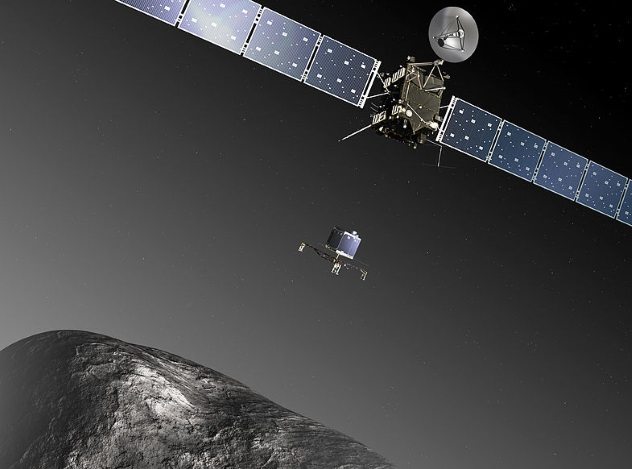
Back in 2014, one of the biggest space-related news stories of the year was when the Rosetta spacecraft successfully landed the Philae module on a comet for the first time in history. It carried on with its mission until 2016, when Rosetta crash-landed on comet 67P/Churyumov–Gerasimenko. During that time, the spacecraft sent a treasure trove of information back to the European Space Agency (ESA), and it seems that, even a year later, we are still finding out new things.
According to a study published by the Royal Astronomical Society, data from the Rosetta spacecraft revealed the missing link of planet formation.[2] The research team concluded that the 4.5-billion-year-old comet is made up of millimeter-sized dust pebbles on the outside layers, which mix with ice pebbles inside the comet. Currently, only one model used for the formation of large bodies in the young solar system could account for this composition: the solar nebula model.
As per this line of thinking, the dust pebbles were initially formed in the solar nebula and constantly combined through collision to form a larger body with an increased gravitational attraction. According to this theory, these pebbles concentrate so strongly that their joint gravitational force eventually leads to a collapse. However, comet 67P is small enough that it hasn’t reached that point yet, allowing scientists to confirm the notion for the first time. The process acts as “middleman” between two well-established operations: the formation of minute dust pebbles, which represent the “planetary building blocks,” and the gravitational accretion of planetesimals to form giant planets.
8 Solving The Mystery Of The Disappearing Star

In 1437, Korean astronomers recorded a new star appearing in the sky in a previously described constellation. Although puzzling, what happened later was even more curious. After 14 days, the star disappeared. It took almost six centuries, but scientists finally found the source of this odd phenomenon.
According to a team led by Dr. Michael Shara of the American Museum of Natural History, the mysterious star is part of a cataclysmic variable. This formation typically consists of a white dwarf and a regular, mass-transferring star called a donor star. When the temperature and density reach high enough levels to ignite nuclear fusion reactions, the white dwarf unleashes a burst of energy called a nova. This astronomical event is incredibly bright and represents what the Korean astronomers saw. After a few weeks, the nova faded away, and the “new” star disappeared once again.
The discovery was made possible thanks to the accuracy of the Koreans, who recorded their sighting in Seoul on March 11, 1437, between the second and third star of the sixth lunar mansion.[3] Even so, Shara had to consult with historians and cross-examine Chinese astronomical maps to pinpoint the location of the white dwarf.
More importantly, Shara believes the discovery validates a hypothesis of his stating that two types of binary stars are actually two stages of the same type of star. According to him, the nova-like binary star, which typically consists of a white dwarf and a red dwarf, eventually cools down and becomes a dwarf nova.
7 Determining The Chances For Life On Enceladus
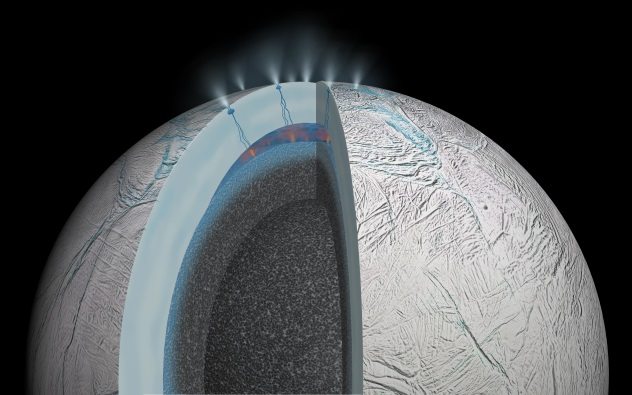
A study published in the journal Science indicates that the same kind of chemical reactions which are responsible for sustaining life on Earth near deep-sea hydrothermal vents could also be happening in the subsurface ocean of Saturn’s moon, Enceladus. This conclusion comes as the result of a 2015 flyby of the Cassini probe, which passed through an ice plume and detected molecular hydrogen (H2) using its on-board mass spectrometer.
The team behind the study opines that the H2 is most likely being produced continuously by reactions between hot water and rock in and around the moon’s core.[4] This is backed up by an earlier 2016 study, which found that silica grains detected by Cassini on Enceladus were likely produced in hot water at significant depths.
On Earth, microbes in deep-sea hydrothermal vents engage in a primitive metabolic process called methanogenesis. Cassini’s measurements suggest that Enceladus’s ocean has the resources necessary to sustain this action. However, researchers stress that these new findings do not suggest a detection of life, but rather an increase in habitability.
Enceladus has become one of the main targets for potential extraterrestrial life ever since we found out it has underground water in 2005. Both private and government space agencies are considering missions in the 2020s to send probes equipped with life-detection equipment through the moon’s geyser eruptions.
6 Finding The Truth Behind The Weird! Signal
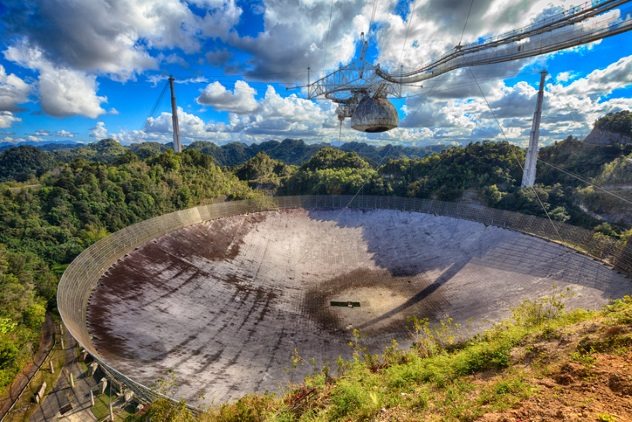
Back in 1977, astronomers at Ohio State University were casually monitoring the skies for extraterrestrial intelligence when they picked up an anomalous radio transmission which appeared to be alien in origin. The scientists were so astounded that one of them couldn’t help but write “Wow!” on the printout of the readings, and it became known as the Wow! signal. This year, we had the Weird! signal.
Researchers first picked up this strange transmission on May 12 at the Arecibo Observatory in Puerto Rico. The source appeared to be Ross 128, a red dwarf star with no known planets located 11 light-years away from Earth. For ten minutes, the signal was observed to be “almost periodic,” after which it disappeared forever.
Obviously, when the announcement was made, the first reaction of many people was to think of aliens. However, while admitting that the signals were “very peculiar,” the Arecibo team opined that they were more likely the result of radio interference from human satellites or a stellar flare. Subsequently, a joint effort between the Puerto Rican astronomers and multiple SETI institutions confirmed that the Weird! signal came from geostationary satellites orbiting the Earth.[5]
That wasn’t the last we heard of Ross 128, though. In November, astronomers announced that the red dwarf does, actually, have a planet orbiting it. Not only that, but it’s an Earth-like planet with a slow rotation, and at a distance of 11 light-years, it is the second-closest candidate for alien life outside our solar system. It’s also got an advantage over Proxima Centauri b, the closest exoplanet, because it orbits a much less volatile red dwarf, which doesn’t emit as many radiation bursts that could potentially destroy its atmosphere.
5 Observing Two Neutron Stars Colliding
Representing the collapsed cores of giant stars gone supernova, neutron stars are a rare and mysterious sight. This year, we had a front-row seat to an even rarer event: the collision of two neutron stars.
Both the LIGO and VIRGO detectors operated during the merger and observed, for the first time ever, both light and gravitational waves from a single cosmic event.[6] Dozens of other telescopes were aimed at the collision, and the resulting data helped us elucidate an impressive number of astrophysical and astronomical conundrums.
For starters, we confirmed that a merger between two neutron stars (called a kilonova) will produce a short gamma-ray burst (GRB). Moreover, the Fermi Space Telescope showed that, as predicted, gravitational waves travel at the speed of light or incredibly close to it.
NASA’s Spitzer telescope captured the longest-wavelength infrared light resulting from the event, which showed the forging of gold, asserting that kilonovas are the main source of heavy elements which can’t form in supernovas.
Of course, this kind of scarce event is bound to raise some questions, not just answer them. Astronomers described the short gamma-ray burst as “odd.” Although it had the brightness of a typical burst, it was, in fact, less than one-tenth as far away as any other recorded GRB. This means that it was incredibly faint, and we’re not sure why. More revelations and speculations will come as scientists unravel the data provided by this unique event.
4 Arguing Between Martian Water and Sand

Back in 2015, the announcement of flowing, liquid water found on Mars became one of the biggest headlines of the year. However, new research suggests that the announcement was erroneous, as the flows were probably made of sand, not water.
Since their first observation, these Martian features, called “recurring slope lineae” (RSL), have been found in over 50 areas. They appear as seasonal dark streaks which extend downhill gradually in warm seasons, disappear during winter, and then return the next year. Only seeping water does this on Earth, so we thought the same applied to Mars. However, a new report from the Astrogeology Science Center in Flagstaff, Arizona, suggests that the behavior of the streaks resembles that of granular flows. Specifically, scientists argue that Martian RSL are only found on slopes steeper than 27 degrees, where the angle of repose matches that of Earth sand dunes.[7] If they consisted of flowing water, they should have extended to shallower slopes.
The matter is far from settled. Flowing sand cannot completely account for certain traits of RSL, such as the seasonal appearance, gradual growth, presence of hydrated salts, and their rapid fading when inactive. Some experts believe that RSL could form through a mechanism unique to Mars, which would require on-site investigation to fully understand.
3 Determining The Fate Of The Zombie Star
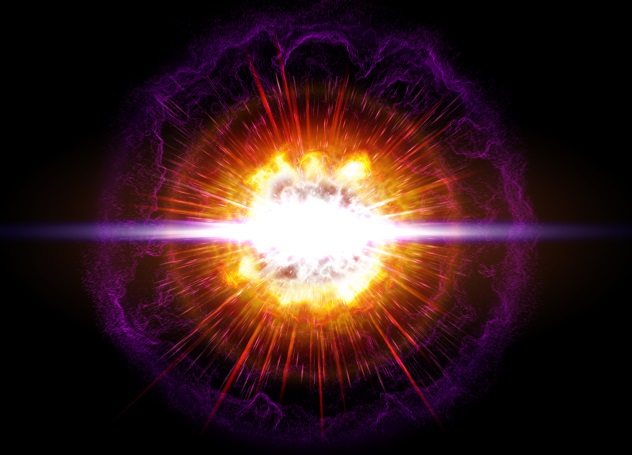
Back in September 2014, the automated wide-field survey known as the Palomar Transient Factory (PTF) discovered a new star. It was supposed to be a run-of-the-mill star, so it was given the unremarkable name iPTF14hls. Even when it exploded, it still looked like a standard Type II-P supernova, which would have faded away after 100 days or so.
And it did . . . at first. However, within a few months, the star inexplicably started to grow brighter. From then until now, iPTF14hls has fluctuated between dim and bright at least five times. Once astronomers realized they had an unusual star on their hands, they went through the archive and found something even more surprising: Another supernova was detected in the exact same location in 1954.[8]
It would appear that the star went supernova, survived for 60 years, and then did it again. It could be what some people have dubbed a “zombie” star. One idea put forward claims that the star is the first confirmed example of a pulsational pair–instability supernova—a star so massive and hot that it generates antimatter in its core. This would make it incredibly unstable and lead to repeated eruptions before a final explosion and collapse into a black hole.
Not everyone is on board with this theory, arguing that it doesn’t line up with all the facts. Astronomer Andy Howell says such explosions were only expected during the early universe and compares it to finding a dinosaur alive today.
2 Welcoming Our First Interstellar Visitor
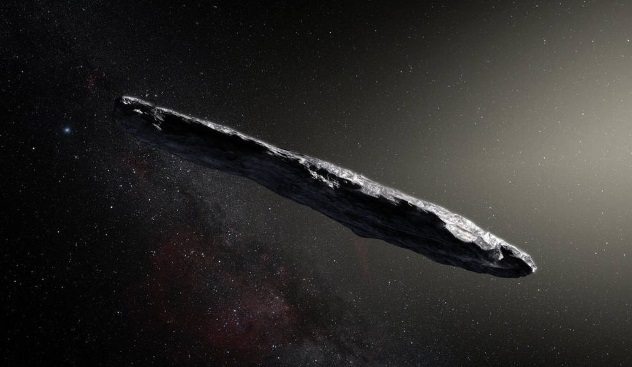
Earlier this year, we discovered the first confirmed interstellar visitor to pass through our solar system. The reddish, cigar-shaped interloper was first thought to be a comet, although closer inspection using the Very Large Telescope (VLT) revealed the lack of a coma. Subsequently, it was reclassified as an asteroid and given the Hawaiian name ‘Oumuamua, meaning “a messenger from afar arriving first.”[9]
The rocky object is highly elongated, measuring over 400 meters (1300 ft) long but less than 40 meters (130 ft) wide, which is an aspect ratio not seen in any other comet or asteroid observed in the solar system. ‘Oumuamua also varies in brightness by a factor of ten as it spins on its axis every 7.3 hours, which, again, is not a phenomenon we have ever observed in other rocky celestial bodies from our galactic neighborhood.
Our current best guess suggests that ‘Oumuamua came from the direction of the star Vega from the constellation Lyra, although the journey took so long that the star was not actually near that position at the same time as the asteroid.
Although ‘Oumuamua is a first, astronomers remain hopeful that more interstellar objects will be found thanks to new, powerful survey telescopes like the Pan-STARRS. In the meantime, scientists are debating whether it is feasible or not to send a probe to the asteroid. The biggest problem is that ‘Oumuamua is currently speeding through our Solar System at 138,000 kilometers per hour (86,000 mph), more than twice as fast as any man-made object sent into space. Even so, some believe it is possible to catch up and might attempt to do so as part of the newly launched Project Lyra.
1 Identifying The First White Dwarf Pulsar
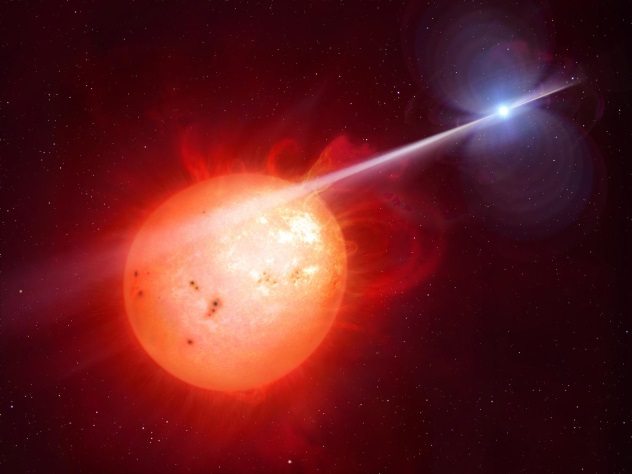
In February, the University of Warwick announced the identification of a white dwarf pulsar—the first of its kind in the known universe.[10]
Typically, pulsars are made from neutron stars which emit beams of electromagnetic radiation at regular intervals. Since the radiation can only be observed when the beam is pointing toward our planet, this creates the pulsing appearance of the emission. People have long speculated that pulsars can also be created from white dwarfs, and this year, we finally received confirmation.
The stellar remnant in question is called AR Scorpii and is located 380 light-years away from Earth in the constellation Scorpius. Like all white dwarfs, this one is incredibly dense. Although it is roughly the same size as our planet, its mass is 200,000 times greater. AR Scorpii is part of a binary system along with a red dwarf, which gets lashed by beams of radiation approximately once a minute—1.97 minutes for a full rotation.
The recent discovery has already presented a new mystery to scientists. They were expecting the binary system’s brightness to vary on timescales of minutes and hours—minutes due to the movement of the radiation beam and hours due to the orbital periods of the stars. But when they compared their findings with archival data going back to 2004, they found variability that stretches across decades. This is almost certainly due to interaction between the two stars, and scientists are now working on a model which can predict these long-term variations.
For more space discoveries, check ouy 10 Intriguing Kepler Space Telescope Discoveries and 10 Recent Space Discoveries No One Can Explain.








